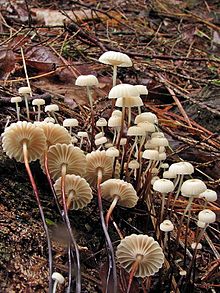| Marasmius rotula | |
|---|---|

| |
| Scientific classification | |
| Domain: | Eukaryota |
| Kingdom: | Fungi |
| Division: | Basidiomycota |
| Class: | Agaricomycetes |
| Order: | Agaricales |
| Family: | Marasmiaceae |
| Genus: | Marasmius |
| Species: | M. rotula
|
| Binomial name | |
| Marasmius rotula | |
| Synonyms[3] | |
| Marasmius rotula | |
|---|---|
| Gills on hymenium | |
| Cap is convex | |
| Hymenium is free | |
| Stipe is bare | |
| Spore print is white | |
| Ecology is saprotrophic | |
| Edibility is inedible | |
Marasmius rotula is a common species of agaric fungus in the family Marasmiaceae. Widespread in the Northern Hemisphere, it is commonly known variously as the pinwheel mushroom, the pinwheel marasmius, the little wheel, the collared parachute, or the horse hair fungus. The type species of the genus Marasmius, M. rotula was first described scientifically in 1772 by mycologist Giovanni Antonio Scopoli and assigned its current name in 1838 by Elias Fries.
The fruit bodies, or mushrooms, of M. rotula are characterized by their whitish, thin, and membranous caps up to 2 cm (3⁄4 in) wide that are sunken in the center, and pleated with scalloped margins. The slender and wiry black hollow stems measure up to 8 cm (3 in) long by 1.5 mm (1⁄16 in) thick. On the underside of the caps are widely spaced white gills that are attached to a collar encircling the stem. The mushrooms grow in groups or clusters on decaying wood such as fallen twigs and sticks, moss-covered logs, and stumps.
Although many mushrooms release their spores in response to a circadian rhythm, spore release in M. rotula is dependent upon sufficient moisture. Dried mushrooms may revive after rehydrating and continue to release spores for up to three weeks—a sustained spore production of markedly longer duration than other typical agarics. There are several species of Marasmius with which M. rotula might be confused due to somewhat similar overall appearances, but differences in size, gill arrangement, and substrate are usually sufficient field characteristics to distinguish them. M. rotula mushrooms are not generally considered edible. They produce a unique peroxidase enzyme that is attracting research interest for possible use in bioengineering applications.
- ^ Cite error: The named reference
Gray 1821was invoked but never defined (see the help page). - ^ Cite error: The named reference
Kuntze 1898was invoked but never defined (see the help page). - ^ Cite error: The named reference
urlSpecies Fungorum Synonymy: Marasmius rotulawas invoked but never defined (see the help page).